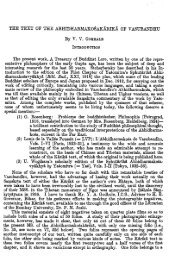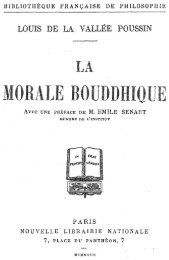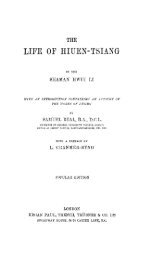La Vallée Poussin Musīla and Nārada. The Path - Gampo Abbey
La Vallée Poussin Musīla and Nārada. The Path - Gampo Abbey
La Vallée Poussin Musīla and Nārada. The Path - Gampo Abbey
You also want an ePaper? Increase the reach of your titles
YUMPU automatically turns print PDFs into web optimized ePapers that Google loves.
Musıla <strong>and</strong> N›rada. <strong>The</strong> <strong>Path</strong> of Nirv›˚a: by Louis de <strong>La</strong> <strong>Vallée</strong> <strong>Poussin</strong><br />
<strong>The</strong> latter, which is purely intuitive, engages the object-referent independent of its name, <strong>and</strong> is<br />
the only effective one. It envisions the truths with a discrimination sharpened by<br />
concentration. 18<br />
2. For the Sarv›stiv›dins, who continue a long tradition, the ‘concentration’ par excellence is<br />
meditation (dhy›na), especially the fourth meditation. 19<br />
After the failure [to attain nirv›˚a] through his attempts at ‘pure yoga’ in the school of the<br />
teachers who taught the third <strong>and</strong> the fourth formless equipoise, ⁄›kyamuni decided to practice<br />
the meditations (dhy›na): “This is the path of enlightenment” (eso va maggo bodh›ya). (By means<br />
of the mundane path of detachment), he ascended to the fourth meditation, <strong>and</strong>, while abiding<br />
there, he acquired the three ‘clear knowledges’ (vidy›) <strong>and</strong>, excellently, the third, the cognition<br />
of the destruction of fluxes (›sravak˝aya) by means of the vision of the truths. 20<br />
<strong>The</strong> ‘easy route’ (sukh› pratipad) is the four meditations (dhy›na) because insight (vipaŸyan›) <strong>and</strong><br />
calm abiding (Ÿamatha) are balanced there. 21<br />
<strong>The</strong> first three formless equipoises are the ‘difficult route’ (du¯kh› pratipad) because the power of<br />
insight is weak <strong>and</strong> calm abiding is strong there.<br />
<strong>The</strong> fourth formless equipoise is excluded: in it one cannot ‘envision the truths’ because<br />
the power of insight is almost zero <strong>and</strong> calm abiding is very developed in it. 22<br />
3. Nevertheless, according to the Sarv›stiv›dins, the actual meditation, the ‘fundamental’<br />
(maula) meditation, is not indispensable. Before each meditation, each equipoise (sam›patti),<br />
there is a preliminary stage called ‘preliminary concentration’ or ‘threshold’ (s›mantaka). In the<br />
‘preliminary concentration’ of the first meditation (called ‘preparatory meditation’ [an›gamya]),<br />
the practitioners are able to produce a pure mind, envision the truths, achieve arhathood. 23<br />
18 KoŸa, vi, 143. – Cultivation (bh›van›) is a mystical state. It presupposes virtues of moral <strong>and</strong> monastic<br />
order, good discriminating customs (‘the two withdrawals’ (vyapakar˝a), ‘the four stocks’), but it is obtained<br />
only by practices, almost physiological, of disgust (‘contemplation of the corpse, etc.’) <strong>and</strong> by the<br />
hypnotic [?] methods (‘mastering of breathing’). – <strong>The</strong> KoŸa attempts, moreover, to intellectualize these<br />
processes, vi, 145-150.<br />
19 Harivarman, chap. 158 (on the four ‘cultivations of concentration’ [sam›dhibh›van›], KoŸa, viii, 192;<br />
Dıgha, III, 222): “According to certain masters, only the fourth meditation is effective: this opinion is not<br />
justified”.<br />
20 Majjhima, I, 246. – It is not a matter here of the path of cultivation.<br />
21 KoŸa, vi, 279.<br />
22 Contradiction between Aºguttara, IV, 422 <strong>and</strong> 426; KoŸa, vi, 236.<br />
23 KoŸa, viii, 178-180; vi, 228, 235. – However, the ‘preparatory meditation’ (an›gamya), like the intermediate<br />
meditation (dhy›n›ntara), is the ‘difficult route’ because calm abiding is weak in it.<br />
12






